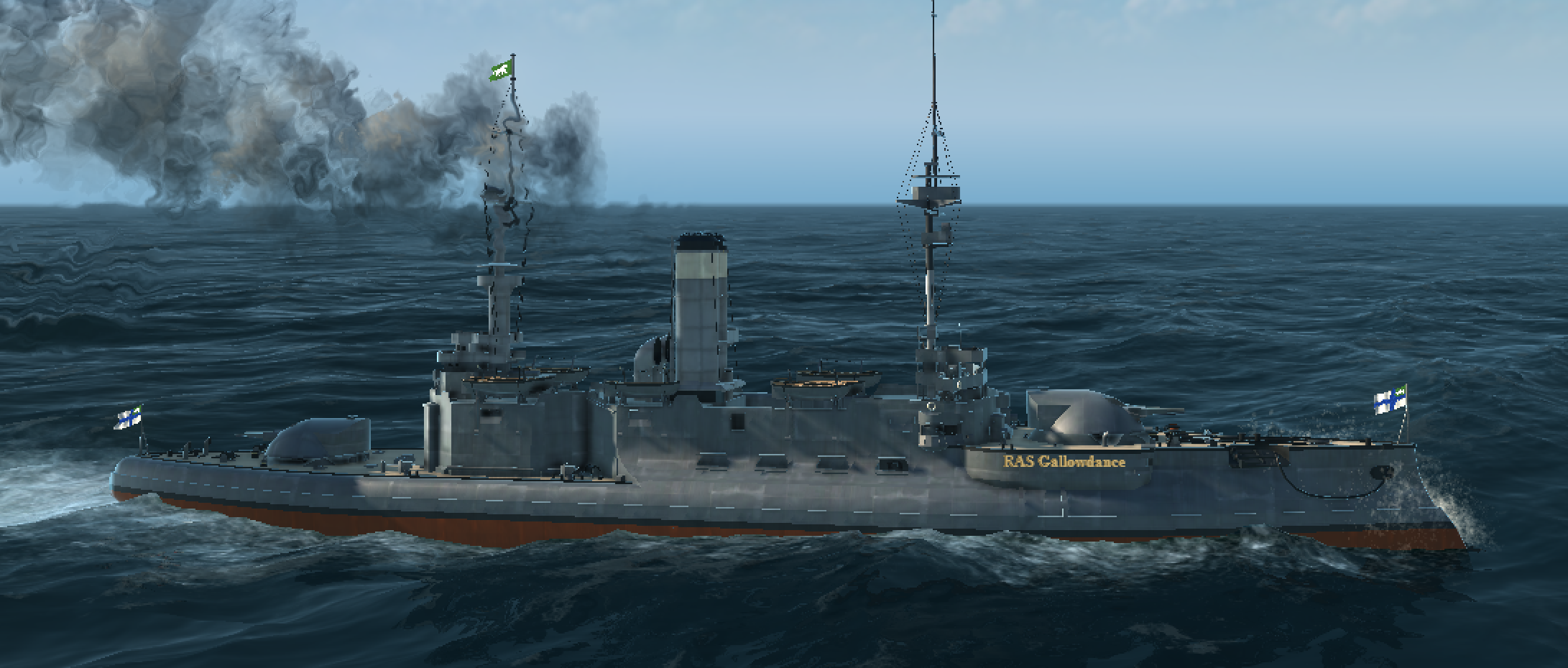Gallowdance-Class Ironclad
Ships in Class
RAS Gallowdance (Decomissioned in 1889) RAS Callenvald (Sunk during the War of Haarvian Sucession)Operational History
The RAS Gallowdance, an ironclad warship of Acentian origin, was commissioned in 1866 during a period of intense naval development in Acentia. Named after the port in which she was built, Gallowdance, it was constructed in response to advancements in naval technology, particularly the transition from wooden-hulled ships to ironclad vessels. The design of the RAS Gallowdance incorporated both iron plating and steam propulsion, marking a significant advancement in maritime warfare capabilities for Acentia. During its service from 1866 to 1889, the RAS Gallowdance participated in several key naval engagements and diplomatic missions, solidifying its reputation as a formidable warship in the Acentian Navy. Its armament included a combination of heavy guns and defensive measures designed to withstand enemy fire, reflecting the technological innovations of the era.War of Haarvian Sucession
During the War of Haarvian Succession from 1869 to 1871, the RAS Gallowdance played a pivotal role in Acentia's naval operations against the Haarvian and Grabbenheim Navies. This conflict arose from disputed territorial claims and political tensions in the region, escalating into a full-scale maritime war. The RAS Gallowdance, as one of the flagship vessels of the Acentian Navy, participated in numerous engagements throughout the conflict. Its ironclad construction provided significant protection against enemy fire, allowing it to withstand attacks and maintain operational capability during intense naval battles. Key engagements during the war included decisive naval clashes in the Haarvian Sea and along the coastlines of disputed territories. The RAS Gallowdance's armament, which included heavy guns capable of long-range bombardment, contributed to Acentia's strategic advantage in these confrontations. It played a crucial role in escorting Acentian troop convoys, blockading enemy ports, and providing artillery support during amphibious operations. The war highlighted the effectiveness of ironclad warships like the RAS Gallowdance in modern naval warfare, where armored protection and steam-powered propulsion systems offered a decisive edge over traditional wooden-hulled vessels. Despite facing formidable opponents in the Haarvian and Grabbenheim Navies, the RAS Gallowdance's contributions helped secure key victories for Acentia and reinforced its naval dominance in the region. By the end of the War of Haarvian Succession in 1871, the RAS Gallowdance had earned a reputation as a symbol of Acentian naval prowess and technological innovation, marking a significant chapter in its illustrious service history.Later
Over its operational lifespan, the RAS Gallowdance underwent periodic refits and upgrades to maintain its effectiveness amidst evolving naval tactics and technologies. However, by the late 1880s, newer classes of warships with superior armor and armament began to overshadow its capabilities. Consequently, the decision was made to decommission the RAS Gallowdance in 1889, marking the end of an era for Acentian ironclad naval power. Despite its retirement from active service, the legacy of the RAS Gallowdance endured through its contributions to Acentia's naval history and the broader evolution of naval warfare during the late 19th century.Power Generation
The Ship is powered by a 7,000hp Coal burning steam engine that can bring the ship to a decent 18.1 Knots on calm seas with an engine efficency of 55%.
Propulsion
The Gallowdance-Class is propelled by dual 72" Screws mounted aft of the ship for an acceleration rate of 1.138 kn/s. Additionally, a steam assisted rudder allows for a 1.59deg/s turn rate while at full speed.
Weapons & Armament
As for weapons , the ship is equipped with two dual 11" Gun turrets mounted fore and aft, two Single 5" Guns mounted fore, Eleven single 2in casemate guns, and finally four deck mounted single 2in guns. All the ammunition for the ship is stored in two main magazines under each turret.
Armor and defense
| Main Belt | 9" |
| Fore Belt | 3.2" |
| Aft Belt | 3.1" |
| Main Deck | 1" |
| Fore Deck | 2" |
| Aft Deck | 1" |
| Conning Tower | 10.1" |
| Superstructure | 1" |
| Turret | 13.5" Sides/ 2" Top |
Communication Tools & Systems
The Ships In this class were at first Given only flares and flags to communicate with but eventally just a few years before they exited service they were given spotlights for morse code.
Additional & auxiliary systems
Iron Plate Armor
Single Bottom Hull
Brown Powder Propellant
Hydraulic Turret Traverse
Designation
RAS
Motto
στη νίκη, ή στην αγχόνη (To Victory, Or the Gallows!)
Manufacturer
Creation Date
first Built 1869
Decommission Date
Last Decomissioned 1889
Owning Organization
Price
A705,000 Ducats
Rarity
2 in Class
Width
79' 1"
Length
400' 8"
Weight
9,416 Tons
Speed
18.1 Knots
Complement / Crew
620 Souls




Comments